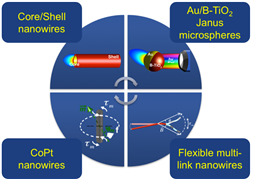ERICA 소재부품융합 첨단제조장비 혁신인재 교육연구단
- 첨부파일없음
2022학년 2 학기 일번째 정기세미나를 다음과 같이 개최하오니, 연구단 참여 대학원생 및 교수님들의 많은 참여를 부탁드립니다.
이번 강연에는 나노광전자학과 김재균 교수님의 초청으로 한양대 에리카 로봇공학과 장범진 교님을 모시고 세미나를 개최합니다.
--------------------------------------------------------- 정기 세미나 ----------------------------------------------------------
1. Title: Untethered small-scale robots, powered by external energy
2. Speaker: 장범진 교수(한양대 에리카, 로봇공학과)
3. Date & Time: Nov. 30 (Wen.) 2022. 13:00 PM
4. Place: 컨퍼런스홀 101호
5. 발표 내용
Untethered small-scale robotsare mechanical objects capable of being wirelessly powered and propelled in fluid environments.
These tiny automata can be precisely controlled to locations where human access is restricted. Consequently, small-scale robots
can be widely applicable in different fields [1] Small-scale robots (or micro-nanoswimmers) are often designed differently from
their macro-sized counterparts for two reasons. First, while macro-sized robots typically use onboard batteries, micro-nanobots
use external energy due to the current technological restriction of battery miniaturization. Second, small-scale robotscreate a propulsive
force in response to external energy. Unlike macro-sized robots, small-scale robots swimming in a fluid by reciprocal motion show zero
net displacement since the drag force exerted on objects dominates over the inertial force at such small scales.[2] To overcome this
challenge, small-scale robots employee unique swimming strategies similar to microorganisms in nature.
In this talk, we discuss how micro-sized living entities propel in fluids and apply their swimming strategies to small-scale robots.
In order to achieve the swimming strategies inspired by nature, four different small-scale robots are newly designed by controlling
their properties, such as geometry, material, physical, and chemical properties. [3-5] Furthermore, their propulsion mechanisms are
understood for efficient and controlled propulsion by fully characterizing their resultant locomotion in Newtonian fluids.

Fig. 1 Schematics of four different small-scale robots that will be presented in the talk.
[1] K. E. Peyer, L. Zhang, B. J. Nelson, "Bio-Inspired Magnetic Swimming Microrobots for Biomedical Applications", Nanoscale, Vol. 5, No. 4,pp. 1259-1272, 2013.
[2] E. M. Purcell, "Life at Low Reynolds Number", American Journal of Physics, Vol. 45, No. 1, pp. 3-11, 1977.
[3] B. Jang et al., "Undulatory Locomotion of Magnetic Multilink Nanoswimmers", Nano Lett., Vol.15, No. 7, pp. 4829-4833, 2015.
[4] B. Jang et al., "Catalytic Locomotion of Core-Shell Nanowire Motors", ACS Nano, Vol. 10, No. 11, pp. 9983-9991, 2016
[5] B. Jang et al., "Multiwavelength Light-Responsive Au/B-Tio2 Janus Micromotors", ACS Nano. Vol. 11, No. 6, pp. 6146-6154, 2017
----------------------------------------------------------------------------------------------------------------------------
많은 참석 부탁드립니다.
감사합니다.

